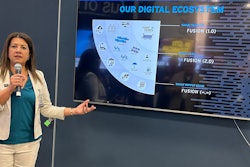With inflation continually driving costs up and demand for freight down, experts say growth in the freight market will be modest throughout 2024. This economic outlook has landed the economy at the top of the 2023 Critical Issues in the Trucking Industry list recently released by the American Transportation Research Institute.
GDP in the goods transport sector – the economy tied to freight transportation – is “pretty ugly,” Avery Vise, vice president of trucking at FTR Transportation Intelligence, said at a recent Transportation Intermediaries Association meeting. And the ever so slight growth expected in 2024 – we’re talking an average of 2.7% over four quarters – isn’t going to amount to a great deal of change from what has been the stagnant status quo.
McLeod Software President and CEO Tom McLeod said when the economy is slow, that’s the perfect time to invest in technology and expand operations to prepare for the stronger comeback. BlueGrace Logistics Chief Technology Officer Azad Ratzki offers advice on several tech advancements that can enable companies to optimize operations, enhance efficiency and drive growth despite market volatitlity.
These three technologies, he said, can help carriers survive a bearish economy and thrive in a bullish economy: large language models (LLMs), freight optimization platforms and no-code automation.
“By using LLMs such as OpenAI’s ChatGPT for communications, freight optimization strategies employing the use of pooling, and the automation of repetitive processes using the variety of no-code options available on the market, there has never been a better time revisit and reevaluate the way organizations operate,” Ratzki said. “While some processes may be tried and true, a bearish market is vitally important to the growth of the economy, helping driving innovation and finding new, untapped opportunities in a more constrained environment. All three of these technologies have the power to radically transform the way businesses perform.”
He said LLMs can help companies automate certain roles or parts of roles, freeing up people for more important human tasks. Anywhere information has to be deciphered, and then a human would normally have had to interact is an opportunity to use an LLM, he said.
Using LLMs, Ratzki said, can streamline any situation that calls for person-to-person interaction and communication with even some of the subtleties of human nature intact. This could be everything from routinely reaching out to partners to obtain status updates to providing responses to frequently asked or data-driven questions.










